(Above) Sketch for Animal House by costume designer Deborah Nadoolman (Below) Still from Animal House with Jamie Widdoes (left) and Tim Matheson
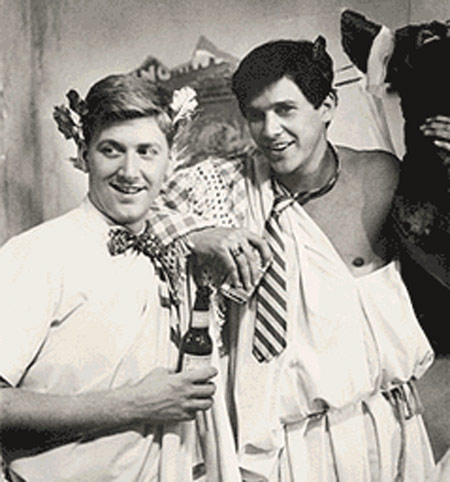
Being on the same page. Speaking the same language. Expressing in shorthand. Call it what you will, but clearly, the search to effectively communicate is one reason why directors team up with the same creative pros time and again. This is evident in every director's choice, including a costume designer.
Director Paul Mazursky (Moscow on the Hudson, Down and Out in Beverly Hills) explains the collaboration process on a film in matrimonial terms. "It's like getting married five or six times," he says. "I marry somebody to get the money, I marry the writer to get the script, and then I marry the costume designer before spending the rest of the shooting married to the DP." How is the director/costume designer marriage different from the rest? It's like two ships passing in the night, say many directors. While the work of the costume designer is visible in every scene in which there is an actor present, directors typically spend less time brainstorming with this top creative person than with the others.
During photography, acting and editing, for example, the director is in the middle of the process. But the art of costume design is a lonely one. The designer must accurately capture the director's vision during often-hurried planning and research meetings before going off to create on his or her own. Besides intermittent flashes of sketchpad drawings, research photos and swatches of fabrics, the director sees the final work of the costume designer when the actor emerges from the trailer for a scene. As budgets and schedules get increasingly tighter, the director has even less time to work with the costume designer. When the two do manage to meet one-on-one, the shorthand often needs to be very short.
Says Mazursky, completing the marriage metaphor: "Using the same costume designer each time is a huge advantage because I don't have to go through that fake honeymoon period when you're just being nice to each other."
Director Spike Lee (Do the Right Thing, Malcolm X) has stayed with the same costume director, Ruth E. Carter, since his first film. "The director is the boss, but he depends on the collaboration and input of other people. He has to be working hand in hand with the DP, the production designer and the costume designer. Those are the people who help him determine the look of the film."
Naturally, when a director finds a costume designer with whom he can speak a common language, he sticks with her (costume design is a predominately female craft, as Costume Designer Guild numbers show that members include 500 women and only 84 men). Mazursky has made 11 films with the same costume collaborator, Albert Wolsky ("so I don't have to have endless conversations with him"), and is one of several top directors in a breed that partners for life. Other longtime costume collaborators include the Coen Brothers and Mary Zophres (five films), Robert Zemeckis and Joanna Johnston (eight films), Spike Lee and Ruth E. Carter (nine films), Mike Nichols and Ann Roth (11 films) and Woody Allen and Jeffrey Kurland (15 films).

(Above) Sketch from Amistad by costume designer Ruth E. Carter (Below) Still from Amistad with Djimon Hounsou.

The job of the costume designer is to "paint" the movie in two ways, says costume designer Deborah Nadoolman. "They fill each frame with a look, and they fill the entire story of the movie ... the costume is the subtext of the character. Even before a character speaks, the costume has already spoken for him." Nadoolman herself is a longtime collaborator with her husband, director John Landis. When Landis started in on his first film, bringing Nadoolman on was a "no-brainer," he says. Since Kentucky Fried Movie in '76, the two have gone on to make 15 films together (including the classic Animal House along with The Blues Brothers, Trading Places, An American Werewolf in London, and Coming to America (for which she was nominated for an Oscar in '88) and the breakthrough Michael Jackson music video Thriller.
"We've been together 27 years, and we've managed to survive all those movies," says Nadoolman, alluding to what might represent the closest relationship a director and a costume designer could possibly have.
"Stick with a good thing" was a common refrain from the directors contacted for this article. Spike Lee on Carter after nine movies together: "I'd like to work on every project with Ruth. She always contributes to the look and feel." Brett Ratner on Betsy Heiman after two movies together: "There's nobody better on contemporary films ... her work is always character-driven. I'd like the collaboration to continue."
"It is all about a working relationship," says director Robert Zemeckis. "You work with someone, and you find that they are speaking the same language, a shorthand. After making the movie, you don't have to start from square one the next time." Zemeckis, known for pushing the envelope on all filmmaking crafts in projects like Who Framed Roger Rabbit and Forrest Gump, is heading into another breakthrough film in Polar Express, based on the classic children's book. Incorporating motion-capture technology to an extent never used before, Zemeckis and longtime collaborator, costume designer Joanna Johnston, are once again in unexplored territory, where shorthand is key.
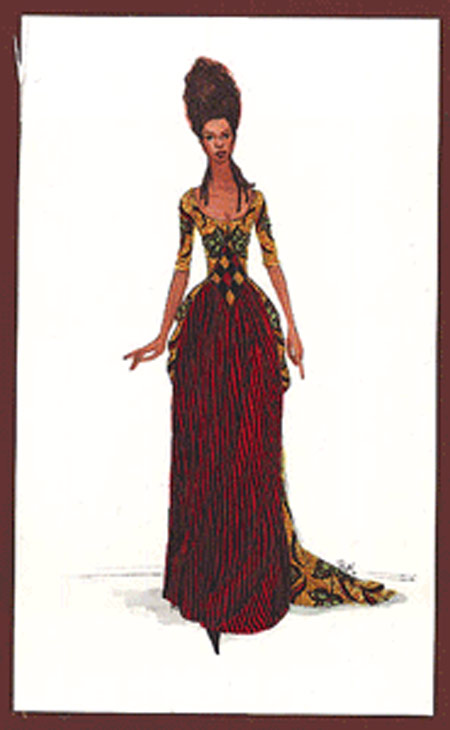
(Above) Sketch of Erykah Badu for Blues Brothers 2000 by costume director Deborah Nadoolman (Below) Still from Blues Brothers 2000 of Erykah Badu.
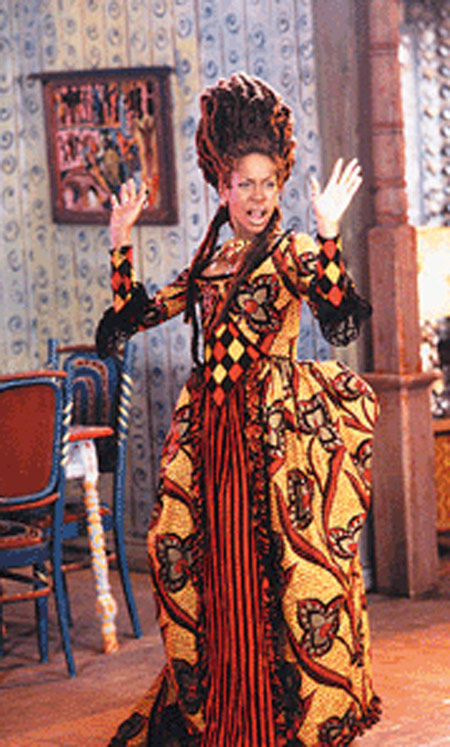
The preparation process for Polar Express is the same as that of normal filmmaking, but instead of being filmed in action, the costume is actually scanned in for the computer. "Polar Express is so out of the box," Zemeckis says. "We don't quite know what's going on there. It's designed one time, just like the skin, the hair."
"It's just a new world," says Johnston. "I'm doing this to the best of my judgment because this is the first time. The overall process is new ground just as Roger Rabbit was. It is a ship breaking through untouched ice, and the person who drives the ship forward is Bob. He is genius in his vision and in chartering new territory. This is my eighth film with Bob, so we really know each other, really well."
Clearly, without rapport or the ability to instantly and precisely communicate with each other, such challenging projects would not be possible. In finding this quick, efficient common language, directors employ different techniques — in words or visuals. "There are only two ways to talk to a costume designer," says Mazursky, "using stuff from other movies or stuff from life or art."
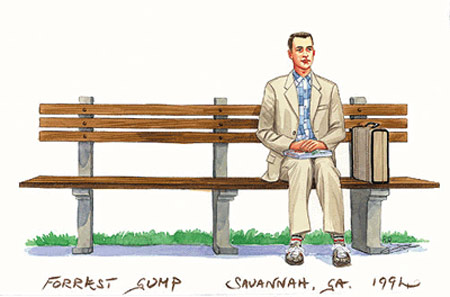
(Above) Sketch from Forrest Gump by costume director Joanna Johnston (Below) Still from Forrest Gump with Tom Hanks.
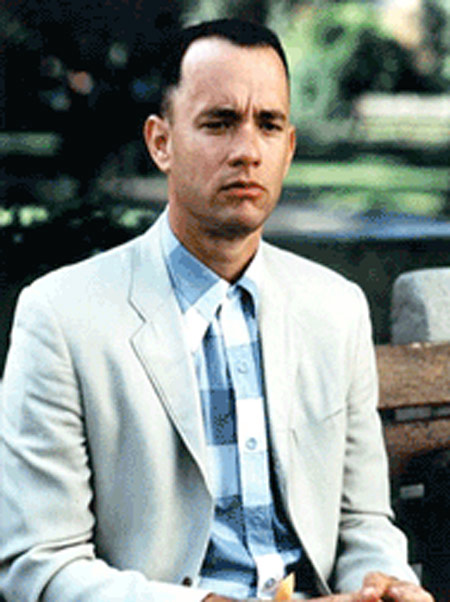
In working with his costume collaborator, Wolsky, Mazursky prefers to point to paintings as inspiration for a film's look, rather than taking a more direct approach like a reference to another film. "It's easier to say, I'd love it to look like The Godfather, then to describe the kind of clothes gangsters wear, but I don't like to do that. When you say a painter, you're giving him a feeling of where your instincts take you."
Other directors, however, do prefer using other films as a reference point. When Steven Spielberg began coming up with the look for Indiana Jones in Raiders of the Lost Ark, he asked his costume designer for the film, Nadoolman, to sit down with him and watch several adventure films from the '30s and '40s. For Red Dragon, director Brett Ratner's vision of the film was expressed in the words "timeless '80s," and that sent costume designer Betsy Heiman to the FBI, where she dug into their vaults for photos of agents two decades back.
The writer/director team of the Coen Brothers is very clear in its direction. Not only do they storyboard every scene, says their costume designer, Mary Zophres, but their scripts themselves are also very evocative. She also finds them extremely articulate in their conversations on the costume choices for a character. "I wish I were as verbal as they are," she adds. When the brothers described what they wanted for O Brother, Where Art Thou? Zophres remembers they said simply, "Think overalls, lots of overalls." "If a director is not the writer," she advises, "they need to understand the material. They should be able to say it's reading like A, but it's really like B. If they can't, it gets confused on the screen too."
Carter also understands the clarity a writer/director brings to the partnership. "With Spike [Lee], there's a different confidence level and an expectation ... when I do a movie with someone else, I have to remind myself it's not Spike."
When the communication does not always flow from the director, designers use their own language. Ellen Mirojnick (Fatal Attraction, Unfaithful) employs the words derived from the five senses, while Betsy Heiman (Family Man, Jerry Maguire) covers the wall of her office with dozens of magazine pages and photos to help settle on a look with the director. Zophres says, "I went to Vassar College, but the more I do this job, the less articulate I become. Visuals are my language." Like many designers, Zophres relies routinely on sketches, swatches of fabric, books and magazines, photographs in family albums and high school yearbooks.
In terms of symbiosis, of course, the nirvana of collaboration is the mind meld. When the communication achieves its highest plane and the director and the costume designer both "just get it," words and visuals become less necessary. This kind of unspoken telepathy begins with a shared sensibility but is arrived at through research, sometimes done together, sometimes independently. Effective costume designers and directors analyze the script and immerse themselves in the world of the characters to the point where they become peer students of the film. If two of the same mind completely learn the nuances of the characters, the subtexts of the story, then the movie takes charge. Sharing a language and a sensibility is not enough to share a vision. Research places the look of the project in the head, and when everything goes right, the costume designer and the director each carry around the same movie in their minds.
While communication is key, of course, what really matters is in the final product. Many times what may seem like kismet on the set looks disharmonious on the screen. In reality, says Nadoolman, "You never know when it's not working. It could be the worst experience of your life, and you leave the movie and you think, 'Oh my God, that's going to be terrible,' but it's great. You just never know. It's a mystery."
When it comes down to it, the real reason for a director to return to the same costume designer time and again, says director John Landis, is a much more selfish one: "When you look at a director who works with the same person over and over again, it's because they are confident they will never be disappointed. That's where that loyalty comes from."